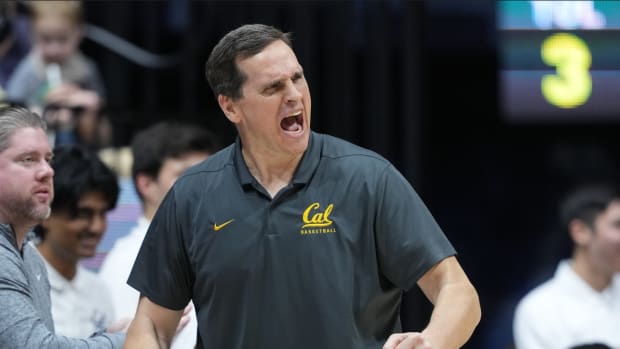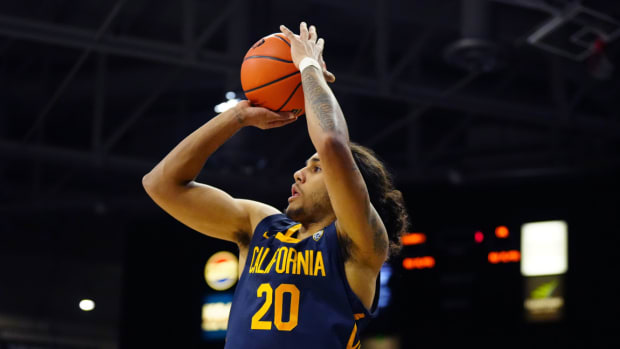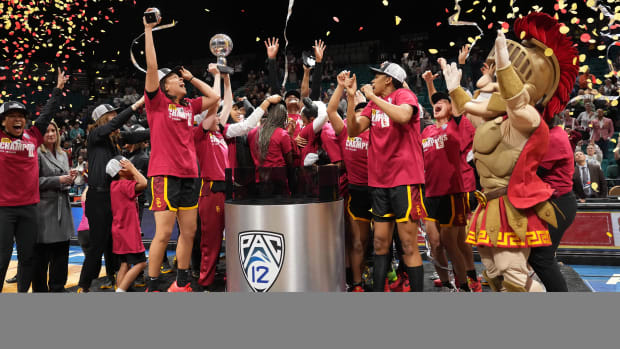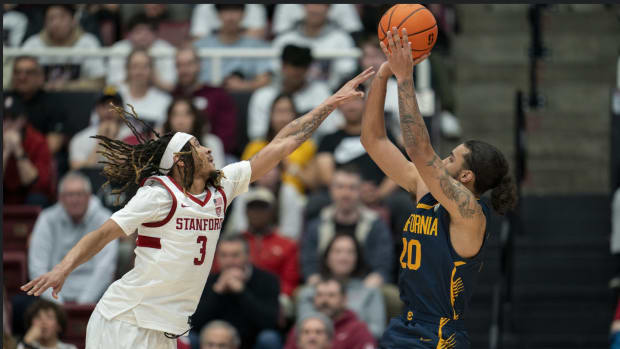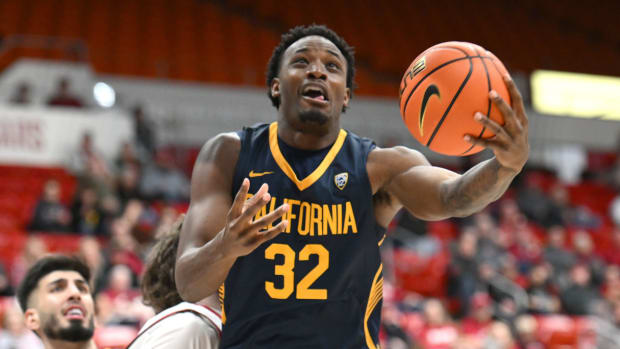NCAA Tournament: For One Unique Season, Turn March Madness into May Mayhem
Change in the sports world is happening fast in the era of the coronavirus pandemic, so maybe it’s time to blow up the most popular event on the calendar.
With the college football season hanging in the balance, is it too early to look ahead to basketball?
In the wake of the 2020 NCAA basketball tournament being wiped out by COVID-19, we’re going to give the 2021 event a complete, one-year facelift.
Instead of 68 teams, make it 128. But streamline the process by possibly eliminating (some) conference tournaments. (More on that in a moment).
Go old-school and — as much as possible — set up four regions that actually reflect geography and thereby aid with travel costs.
Name the four regional events after men whose influence on the game was profound, both in their part of the country and across the hoops landscape:
The West regional becomes the John Wooden Regional.
The Midwest is the Phog Allen Regional. (Sorry, Indiana fans. Bob Knight doesn’t fly these days).
The South is the Dean Smith Regional.
And the East is the John Thompson Regional.
Each of the four regionals will involve 32 teams from eight pre-determined conferences, playing two weekends of games to create a Final Four that truly represents each area of the country.
Why the change?
The likelihood is we will have a shortened hoops season, perhaps starting later than usual, and quite possibly without non-conference games.
With no opportunity for Gonzaga to prove itself against North Carolina, the NCAA’s NET computer ranking has no authentic means of comparing apples and oranges. The so-called eye test is all we’re left with, and that comes with inevitable historical and regional biases.
Instead, given the unprecedented circumstances, we’re going in a different direction. For one year.
Here’s how it could work.
How are the four regions arranged?
Here goes (with the final 2019 RealTime RPI conference rating in parenthesis):
— John Wooden Regional: Pac-12 (3), WCC (9), Mountain West (10), Mid-American (12), Big Sky (18), Summit (22), Big West (24), WAC (28).
— Phog Allen Regional: Big-12 (2), Big Ten (5), American Athletic (7), Missouri Valley (11), Conference-USA (17), Horizon (23), Ohio Valley (29), Southland (30).
— Dean Smith Regional: SEC (4), ACC (6), Sun Belt (11), Southern (13), Atlantic Sun (25), Big South (27), SWAC (31), MEAC (32).
— John Thompson Regional: Big East (1), Atlantic-10 (8), Ivy (15), Colonial (16), Patriot (19), Metro Atlantic (20), America East (21), Northeast (26).
As fans of the Mid-American or Summit or Southland conferences know, our regional alignments aren’t strictly by the map. There are more conferences in the south than the rest of the country, but we did our best to create a geographic and competitive balance.
Who gets in?
First of all, the NCAA committee will not actually select the teams (only seed them). That should make some people happy.
The conferences themselves determine their entries into the 128-team field.
We’ve split the 32 conferences into two tiers — the upper 16 and lower 16, as ranked by the aforementioned RealTime RPI from a year ago.
Each regional features four upper-tier conferences (each of whom sends six teams to the NCAA tournament), and four from the lower tier (whose leagues get two teams apiece).
Who doesn’t get in?
Seventh-place teams from even the big conferences. Seriously, does a seventh-place team truly have a good argument for landing a bid?
How teams are chosen?
Leagues that prefer to play a conference tournament — or believe they can financially benefit from it — are free to do so. But they still will be responsible for handing out their own NCAA bids, whether that’s six or two.
Conferences that choose not to contest a league tournament, will award their bids based on their final standings. And without a league tournament, they will benefit from a week off before the NCAA tournament.
Is there a back-door into the field?
Yes, because no team with a losing conference record would be given an NCAA berth in our format. So for each one of those sidelined, the committee would replace it with the highest NET-rated team not already in the field, presuming that team has at least a .500 record in its league.
In our mock 2020 NCAA field, two spots opened up because neither the Big East nor the Ivy League had six teams with .500 conference records.
What’s next?
After the committee seeds each regional, three rounds of games will be held at eight sites over a five-day span to shrink the 128-team field to a Sweet 16. The next two rounds will be played a week later to settle on a Final Four.

Virginia won the 2019 NCAA title. The tournament was canceled this year.
Photo by Bob Donnan, USA Today
.
Who might have played in the 2020 NCAA tournament?
Based on conference finish, here are the qualifiers:
— John Wooden Regional:
Pac-12 (6): Oregon, UCLA USC, Arizona State, Arizona, Colorado
WCC (6): Gonzaga, BYU, Saint Mary’s Pacific, USF, Pepperdine
Mountain West (6): San Diego State, Utah State, Nevada, UNLV, Boise State, Colorado State
Mid-American (6): Akron, Bowling Green, Ball Stte, Northern Illinois, Buffalo, Kent State
Big Sky (2): Eastern Washington, Northern Colorado
Summit (2): North Dakota State, South Dakota State
Big West (2): UC Irvine and either UC Santa Barbara or Cal State Northridge
WAC (2): New Mexico State, Cal Baptist
— Phog Allen Regional:
Big-12 (6): Kansas, Baylor, Oklahoma, Texas, Texas Tech, West Virginia
Big Ten (7): Wisconsin, Maryland, Michigan State, Illinois, Ohio State, Rutgers, Michigan (gets Ivy League’s No. 6 spot, based on No, 24 NET ranking)
American Athletic (6): Houston, Cincinnati, Tulsa, Wichita State, Memphis, UConn
Missouri Valley (6): Northern Iowa, Loyola Chicago, Bradley, Indiana State, Southern Illinois and either Valparaiso or Missouri State
Conference-USA (2): North Texas and either Louisiana Tech or Western Kentucky
Horizon (2): Wright State, Northern Kentucky
Ohio Valley (2): Belmont, Murray State
Southland (2): Stephen F. Austin and either Nicholls State or Abilene Christian
— Dean Smith Regional:
SEC (6): Kentucky, Auburn, LSU, Mississippi State, Florida, South Carolina
ACC (6): Florida State, Virginia, Louisville, Duke, Georgia Tech, Notre Dame
Sun Belt (6): Little Rock, South Alabama, Texas State, Georgia Southern, Georgia State, Appalachian State
Southern (6): East Tennessee State, Furman, UNC Greensboro, Mercer, Western Carolina, Chattanooga
Atlantic Sun (2): Liberty, North Florida
Big South (2): Winthrop, Radford
SWAC (2): Prairie View A&M, Southern
MEAC (2): North Carolina Central and either North Carolina A&T or Norfolk State
— John Thompson Regional:
Big East (6): Creighton, Villanova, Seton Hall, Providence, Butler, Marquette
Atlantic-10 (6): Dayton, Richmond, Rhode Island, Saint Louis, St. Bonaventure, Duquesne
Ivy (5): Yale, Harvard, Princeton, Penn, Brown (only 5 qualifiers)
Colonial (6): Hofstra, William & Mary, Towson, Delaware State, Charlestown, Northeastern
Patriot (2): Colgate and either Boston or American
Metro Atlantic (2): Siena, Saint Peter’s
America East (2): Vermont, Stony Brook
Northeast (2): Merrimack and either St. Francis or Robert Morris
.
.
Follow Jeff Faraudo of Cal Sports Report on Twitter: @jefffaraudo
Click the "follow" button in the top right corner to join the conversation on Cal Sports Report on SI. Access and comment on featured stories and start your own conversations and post external links on our community page

